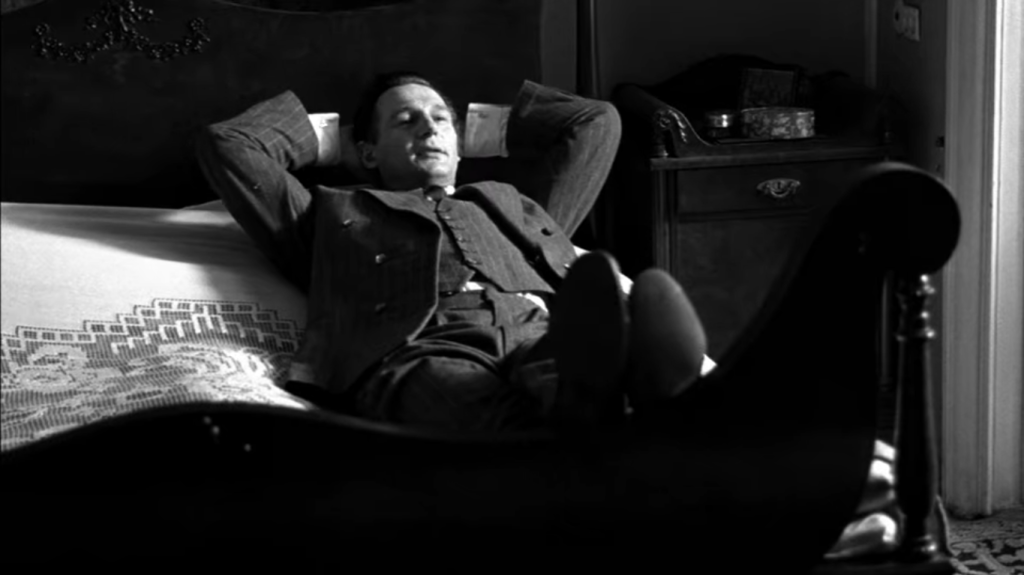Another day, another Film review! This time, Schindler’s List by Steven Spielberg… again.
Schindler’s List made in 1993, is a historical drama based on the real life events of Oskar Schindler, a German industrialist in the Second World War. During this time, Jewish people are stripped of their human rights, and are sent to the ghettos. Schindler sets up a money-making scheme in which he acquires an enamelware factory, and hires Jewish workers. His accountant, Itzhak Stern begrudgingly helps Schindler and seeks out these workers by forging essential worker documents for those who are at risk to be sent to the camps, thus saving the community in secret.

A first impression of Schindler would be that he is egotistical, in the sense that he wants to make money, and will do whatever it takes to do it. Even if it’s befriending Nazi soldiers so he could bribe them. His selfish attitude is poignant more so in his scenes with Stern. The contrast of Stern financing the factory by risking his life, and then Schindler going out to fancy parties, ultimately represents the real life struggle that the Jewish community faced against the Nazi’s during the holocaust.

The film itself is set in black and white, and due to the historic nature of the film gives it a documentary style to it. In many scenes, you are given a point of view shot, which puts you in that moment all those years ago, as if you are experiencing the horrific events of the Holocaust yourself.

During the film, we are introduced to SS Officer, Amon Göth as he is sent to overlook the Płaszów concentration camp. Whilst working, he brutally mistreats the Jewish community, by killing them at random for his own pleasure. He is then given the job to empty the ghetto, and move a number of the residents into the Płaszów camp, however, this leads to the SS shooting and killing the remaining Jewish people in the ghetto. In the distance, Schindler witnesses the mass killings whilst horse riding, and something inside of him breaks. His original mission of making money instantly changes and his new goal is to save as many lives as possible, behind the SS’ back.

From this moment on, Schindler works with Stern as he is imprisoned inside Płaszów. As the conditions worsen in the camp, Schindler then bribes Göth to let him build a separate camp for his workers, to protect them. This works for so long until Göth is given orders to send the remaining prisoners to Auschwitz. In a twist of events, Schindler uses his bribing techniques to move his workers to a new factory away from the camps, thus saving them. To do this, Schindler must create a list of names of the 850 workers. Much to Stern’s surprise, Schindler willingly gave Göth all of his money in order to move his workers. Thus showing Stern that Schindler has changed for the better.

As the War ends, the Jewish people are liberated, however the Nazi’s are arrested. With Schindler being part of the Nazi party, he must flee, leaving Stern and the rest of the workforce behind for them to start a new beginning.
However, as the film ends, we are back in the present day and back in colour, showing the remaining survivors of who Schindler helped. They gather together, along with the actors of the film, and they pay respects at Schindler’s grave, who died in 1974.
The idea of reverting back into the present day reminds the audience that these horrific scenes actually happened, and to make them aware of the history, so it is not forgotten. Whilst there have been scenes that were dramatised, it doesn’t retract from the film’s purpose, to show people a different side to the war, but still showing them the brutality that the Jewish community faced. The explicitness of the violence and the killings are there to shock you, to let you know what really happened.
The film and narrative handled the subject quite fairly. Whilst a film may never be accurate especially during such a pivotal moment in history. Portraying a real life story into mainstream Hollywood Cinema created the awareness, and showed not only Schindler as the hero, but also Stern, and how he assisted Schindler from the inside of the camps.
Again, dramatisations are bound to happen, but the meaning behind the story prevailed, and it showed that there were good people during a time where everything was seemingly destined for failure. Thus giving inspiration to help those in need, even when it seems impossible to do so.

Leave a comment